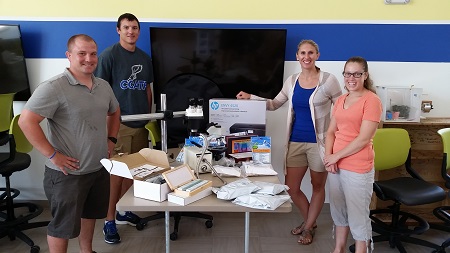School district to teachers: “Okie dokie, science teachers, here’s your supply budget for the year: 40 cents per student, go for it!”
Private foundation to teachers: “No, we can’t give you any extra supply money for your science classroom. Not enough of your students go on to college.”
Is there an emoji for jaw on the ground? There should be. How can science teachers possibly provide the hands-on, inquiry-based science experiences that might actually get a kid excited about science, and motivated to go to college with a supply budget of 40 cents per student per year?
Let me give you a little back story.
Remember the evolution camp we ran a couple weeks ago? We had so many generous local partners that we had some money left over that we could spend in the area. So I asked the science teachers at our camp partner school to write up a wish list and we’d see what we could get them.
Turned out we could get them a lot. Check out the haul:

What did rural science teachers want when given a free ask? Some basic equipment, for sure, but also a surprising amount of gear specifically for teaching about evolution. Their wish list included hundreds of dollars’ worth of evolution education materials. And again, that’s a request coming from rural science teachers, with no nudging. As we suspected, teachers are much more willing to teach topics like evolution and climate change when they have their basic equipment needs are met.
Let’s talk about just how basic these needs are. Simple reagents, inexpensive a/v equipment, and their school’s first microscope. When I delivered this not-very-exotic equipment, the teachers were really excited. Not “yay, Christmas in August!” excited. More like desperate relief. You know, that feeling you get when you surface from deep water and take a breath. Where you can hardly believe there is enough air. Where you feel so grateful there is air to breathe.
District budgets had just come out. These science teachers had had their classroom budgets cut yet again. The number of students they would be teaching had gone up significantly; by as much as 20%. How much money did they have to spend for each student, for the year?
I already told you. Forty cents a head.
What are these teachers supposed to do? Forty cents a head? For a year? What on earth could they do with that budget?
Not to be deterred, the teachers told me that they tried to get extra funding from another source, but were declined. I told you the reason above: not enough of the kids in their district went on to college.
The Catch-22 there is enormous. Before you can get any enrichment funding, somehow you’re supposed to get more kids into college with your budget of forty cents per head. Per year?
These are dedicated, talented teachers. They told me how they’re cobbling together enough resources to get through another year. How much of their own time and money they put in. How much their family members give. Think of how it must feel for them to care so much, to put in so much work, and then get slapped in the face with a budget like that.
People ought to know about these things, but they don’t. It seems to me we hear quite a bit about how school districts have had to cut their budgets for music and the arts (which is terrible, I agree). But most people don’t realize that districts have also put science education on the chopping block. I think people would be mad, real mad, if they knew. But even people who are well informed, and spend plenty of time online, don’t often come across stories about the state of science classroom budgets.
You know, I didn’t know how bad the situation was. Not until I deployed my secret weapon. I’ll tell you about that in a follow-up post.

